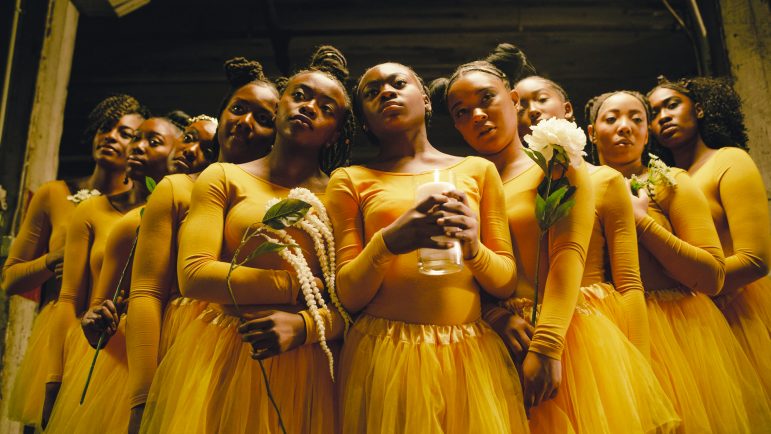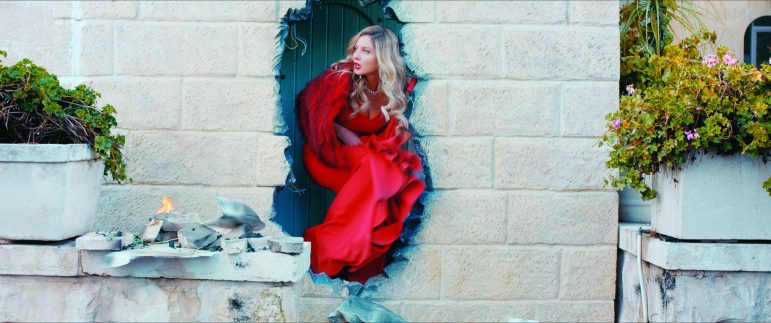Filmmaker and South Bay resident Chris Au never saw Asian faces on movie screens during his excursions to theaters every Friday night while growing up in Pennsylvania.
But that changed in 2002, his senior year in college, when he saw Better Luck Tomorrow, the solo directorial debut of Justin Lin, who would go on to helm installments of the Fast and Furious and Star Trek franchises.
Better Luck Tomorrow played Sundance, got acquired by MTV Films and was released in theaters nationwide. Heralded for pushing the boundaries of how Asian characters are portrayed on screen, it was also one of the opening films in that year’s SF Asian American Film Festival—known today as the Center For Asian American Media’s CAAMFest.
Inspired by Lin’s Hollywood breakthrough, Au has followed in his footsteps. In February, CAAMFest accepted Au’s first TV series, the six-episode Bulge Bracket, into its annual May showcase. Detailing his wife’s life within the “frat-bro” world of investment banking, Au finished the first draft of the script in 2012.
“The first time I showed my wife the first rough cut of Bulge Bracket, it made her tear up because she felt seen. I think that’s something people in general are looking for,” Au says. “When I look back on [Lin’s] career and how he got started, that’s sort of what I was hoping for my career—playing these film festivals, continuing to grow as a filmmaker, hopefully get a film acquired and be in theaters.”
Au landed in the Bay Area after bopping between coasts for his work on the business side of entertainment and digital media. He dusted off the script in 2017, scrubbing out-of-date references like Blackberry phones, and it was picked up as a series by Amazon Prime amid surging interest in Asian-American-centered projects after the success of films like Crazy Rich Asians and Parasite. Season one debuted this summer.
It has also played three film festivals this year, including CAAMFest.
But thanks to the Covid-19 pandemic, none of it went down quite as planned. Back when it was accepted to the San Francisco festival in February, he had no idea all of his appearances and screenings so far this year would be virtual, as he still held out hope for a return to in-person events and audience Q&As. “That was the time when people didn’t know how long the pandemic was going to last,” Au says.
Festivals Reinvented

A scene from B. Monet’s ‘Ballet After Dark,' set to show at LunaFest. (Photo courtesy of LunaFest)
The Covid-19 pandemic is still raging throughout the U.S., and has turned the film festivals world upside-down. Some movie theaters have reopened since being forced to close in March, but their return has been markedly slower in California than most of the country. Audiences have been so reluctant—and new releases so scarce—that Regal Cinemas shut down all of its more than 500 U.S. theaters again this month.
Audience capacity has also been slashed, meaning the social aspect that drives in-person film festivals is non-existent. Like the rest of the media world, film festivals have migrated online out of necessity.
According to Americans for the Arts, a national nonprofit dedicated to advancing arts and arts education, Covid-19’s had an estimated $14 billion economic impact as of Oct. 14, based on a poll of 120,492 arts and cultural nonprofits nationwide.
Nearly 20,000 organizations reported losing 111 million total audience members and a median $30,000 because of the industry-wide swing to virtual programming. While 96 percent of organizations canceled events, 73 percent focused on increasing their online presence. Meanwhile, most—89 percent—of those polled continued to offer artistic content for the community but nearly one-third of the organizations laid off or furloughed staff—impacting around 112,000 workers.
In Santa Clara County, 98 organizations reportedly lost $8.8 million, mirroring national trends since March. Even so, almost all local arts organizations polled said they were confident their organization would survive Covid’s impacts.
The South Bay is home to several film fests annually, including Cinequest, the San Jose Short Film Festival, Stanford Theater Film Festival and Luna Fest.
Local organizers, filmmakers and film enthusiasts dove in feet first to give indie cinema a fighting chance to be seen.
The Essential Film Fest
After planned celebrations for Bulge Bracket never came to be, the six-episode series opened up to viewers’ web browsers at home through the reimagined CAAMFest FORWARD. Last month, the festival featured a handful of drive-in screenings at Fort Mason, 40 virtual films available on demand throughout the festival week and a pre-recorded Q&A with Au and the cast of his show.
While fortunate that his production was also available to stream on Amazon Prime before and after the online festival, Au laments missing out on the exposure festivals traditionally offer. Covid dashed any hopes of in-person gatherings, which have long given filmmakers the chance to meet fellow creators, would-be future collaborators, producers, buyers and fans. He has always seen those events as a way for new filmmakers to build their names within the industry.
“I remember thinking at that time, my career as a filmmaker might be over before it got started,” he says. “For indie filmmakers, festivals are an essential part of your development. ... There was a mourning for this lost moment.”
Tech Legacy
Halfdan Hussey had no time to mourn. The director and co-founder of Cinequest, the annual festival in San Jose and Redwood City planned for March 3 to 15 of this year, tiptoed through the first week of events with surplus cleaning supplies and hand sanitizer, but pulled the plug by the weekend as the number of coronavirus cases in Santa Clara County increased.
“All of a sudden that was everybody’s focus, people were very scared,” Hussey says. “I showed up for opening night, which we had sold out, and it was half full—it was really creepy. The mayor made a speech, and said to me coming off stage, ‘Well, I hope I can keep this open a few more days.’”
Indeed, the festival lasted only a few more days.
The number of confirmed Covid-19 cases climbed to 20 by March 5, prompting Santa Clara County public health officials to recommend postponing large gatherings—an estimated $1 million economic hit, according to Hussey.
Hussey says half of the originally programmed creatives were able to virtually attend Cinejoy, when the festival resumed seven months later from Oct. 1-14. The rebooted festival was hosted on Cinequest’s own platform called Creatics, a sister company launched in 2018 to create a social community to link creative people and their work.
That accidental two-year head start was vital by June, when engineers and designers began creating Cinejoy’s features, evan as three of them were out sick for weeks dealing with Covid. “Lo and behold, the timing was great,” Hussey says.
Festivals caught off guard had a host of options to stream their collections: AgileLink VOD, Cinando Video Library, Film Festival Flix, CineSend, Eventive, Festivee, Festival Scope, It’s a Short and Vimeo OTT.
Some were more complicated and clunkier than others.
Though they could have just posted films online and sold tickets, leave it to Cinequest—the Silicon Valley festival dedicated to fusing technologic innovation with the creative arts—to go the extra mile.
“We have a legacy, because we empower art with technology,” Hussey says. “There’s more than a Netflix or Amazon experience there, I believe. We wanted to develop our own so that it is ultimately special, uniquely Cinequest.”
The festival picked up right where it left off, offering 120 shorts and features available 24/7 in its showcase. Ticketholders logged on to streaming sites to watch newly released productions through emailed access codes and links. Cinejoy featured “red carpet” pre-recorded interviews with filmmakers, Zoom panels and rough cuts. Reaction buttons and chat bars attempted to allow audience interaction—something filmmakers desperately missed from in-theater screenings—but often went unused in this inaugural experiment.
Hussey first dipped his toe into virtual film festivals 15 years ago, but he says audiences then weren’t as technologically savvy and able to participate. The work of uploading, loading and streaming massive files for full-length feature films that would play on browsers and Palm Pilots was still primitive stuff in 2005 and 2007.
“We had people who participated, but it was such a new world,” Hussey says. “Now with Covid and shelter-in-place, even grandparents are using Zoom. The digital technology world is not strange to people anymore. What we’re doing now with the online virtual world is nothing new for us, it’s just come around.”
Rebuilding Cinema

A scene from 'Mossad,' an Israeli 'Naked Gun'-style spy comedy directed by Alon Gur Arye, which was shown at Jewish Film Festivals around the country, including the Sonoma County Virtual Jewish Film Festival.
Virtual screeners have democratized indie films across the board, as scheduling conflicts and theater capacities prove moot, and cheaper online tickets allow more people to participate in this new version of the film festival.
Brian Newman, former Tribeca CEO turned newsletter slinger, likened this moment to 2006, when Napster decimated predecessor’s revenue and business models. He wrote that the ease and economics of online events will outpace previous festival models, just as Zoom overtook Skype’s household name status.
Lela Meadow-Conner, executive director of the Film Festival Alliance, isn’t holding her breath for that earth-shattering shift. She thinks the energy put into harnessing the positives of virtual screeners will instead thrive alongside the energy of live festivals.
“I think more than anything, people are going to want to—when they feel safe—be together again, and have that experience of watching a movie in the theater where it was intended to be, having that visceral feeling when you laugh out loud, or you’re scared and you’re experiencing that with other people,” Meadow-Conner said in an interview with San Jose Inside. “It might take a lot of work to rebuild those audiences who are appreciative of the theatrical experience that’s beyond the studio blockbuster, but I think that collaboration is key. I do think there will be new models. There’s so many ways to be creative, and we just really need to start thinking differently.”
Until those in-person festival hybrids receive the green light, producers, directors, actors and everyone in between are poised to battle the pandemic to get new films and projects finished in time for the return to theaters.
Sets and studios have started opening after grinding to a halt in mid-March, but health protocols to protect workers—mandated by unions like the Screen Actors Guild and the American Federation of Television and Radio Artists—have kept production slow. Intricate protocols include scaled-down sets, talking restrictions during hair and makeup, wiping down equipment, purchasing masks, sealed lunches, color-coded access armbands and increased payrolls to cover paid medical staff and security.
Amy Glazer, a filmmaker, theater director and professor at San Jose State University, said balancing health concerns with the vitality of the humanities is a surmountable challenge, especially for indie projects.
“We have to be safe, but we have to somehow take care of our spirits,” Glazer says. “Storytellers, we’re used to thinking outside of the box and problem solving. There’s this great union adage: ‘Don’t mourn; organize.’ Figure it out, don’t give up. We had put in too much to just let this film end up on a shelf somewhere. There’s a need for content right now that’s authentic and about being human in a complicated world.”
She was invited to an iteration of in-person events.
Method Fest Independent Film Festival’s first rooftop drive-in premiered her film Beautiful Dreamer, which highlights the dynamics between a lesbian couple, their heterosexual best friends, co-parenting and surrogacy. She said the honking horns and applause gave some semblance of connection with a community of strangers through film, rather than simply emojis or text on a screen.
But Covid-related safety costs could impact investor interest and film plausibility, Glazer said. Consequences may be magnified for films that weren’t screened live and shelved.
“I do think there’s a lot of lost films—especially indie films that were hanging by a thread—because it is going to be more complicated and more expensive,” Glazer said. “I think it hurts everyone, but I think it hurts the indie filmmakers the most, especially people of color and films that are about diversity—films that are not mainstream.”
Burnout Aspect Ratios
Are audiences interested in online film exhibitions? When so much of work, school and family life is already online, who will sign up for more screen time?
Lucho Ramirez, director of Cine+Mas SF, which presents the annual San Francisco Latino Film Festival, says that’s why his organization opted for conservative scheduling.
Anecdotally, he’s not seeing convincing numbers of people participating and Instagram posts he’s seen show some DIY film nights that never get past happy hour.
The financials don’t entirely make sense, either, as many corporate sponsorship budgets went out the window and distributors use revenue-sharing models to stream films,” Ramirez said. Navigating available streaming platforms can also be, at times, clunky.
“There’s no real sense in putting a program together and being ambitious if audiences are still not quite that dependable to be online,” Ramirez said. “Part of my trepidation is just an overabundance of online life, people are consuming so much online. You have to factor in the burnout aspect of people.”
This year’s Latino Film Fest offers a scaled-back sampling in November, with 15 full-length and 30 short films celebrating Latino lives compared to typically 60 to 90 films annually. Now more than ever, Ramirez says film’s role is offering an entertaining escape, especially believing in-person events will trickle back as time goes on.
“I know everyone’s in the same funk of existence right now, so if you have some token gestures of normalcy, it’s still important to do those things,” Ramirez says in a recent phone call. “The way I’ve always approached how we program, it’s about education, activism and entertainment, but we’re living in such a different time right now. As an affected community, whether it’s Covid, immigration or police violence, you almost have to … present something palatable and bring people to the table. There’s a lot of reasons to be angry, but it’s a festival, so you have to be festive. I think this year, we have that escape and entertainment aspect held up as more important.”
Logging On
Here are the festivals going live in and around Northern California.
Latino Film Festival
Postponing the celebration of Latino Heritage Month only briefly, Cine+Mas SF will now host its 12th annual San Francisco Latino Film Festival in November. A scaled back sampling of 15 to 30 projects will be shown from Nov. 27 through Dec. 4.
Sonoma County Virtual Jewish Film Festival
The 25th anniversary of the fest celebrating Jewish films, filmmakers and stories will host six new and recently released full-length features and four shorts. Whether diving into an LGBTQ drama in Tel Aviv or a documentary of an African American rabbinical student in Chicago, the productions are available to watch anytime through Nov. 16.
LunaFest
Virtual showings of Luna Fest, a festival championing women’s narratives and female filmmakers, will continue nationally throughout November. These stories touch on struggles and strength of dealing with trauma through dance therapy, coping with the “shelf life” of entering middle-age and wrangling trans identity with family.
Arab Film Festival
The nation’s oldest and largest Arab film festival keeps its 24-year streak alive. The complexity, richness and culture of Arab life will be brought to life online starting Dec. 3, after four national Arab film and cultural organizations came together to make this online gathering a reality.
San Francisco International Film Festival
Nonprofit SFFilm’s annual Film Festival was cancelled, but its annual Doc Stories film series is still a-go for Dec. 3 to 6, virtually featuring a dozen long- and short-form documentaries and live-streamed discussions with the creatives involved. The full lineup, announced next week, will highlight programing inspired by the spirit of the Bay Area.
Bonus roadtrip: Tahoe Film Fest
For those in the mood to drive out to catch a fest in person, pack up some snacks and fill up the tank for Nevada. The Tahoe Film Fest is still optimistic about putting together its event Dec. 3 to 6, complete with social-distancing, masks and other safety protocols.

